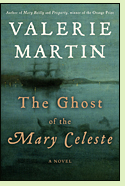The Ghost of the Mary Celeste
by Valerie Martin
Reviewed by Margaret Donsbach Tomlinson

The Ghost of the Mary Celeste revolves around a historical mystery, the disappearance of everyone aboard the ship Mary Celeste in 1872. It was discovered drifting and abandoned near the Straits of Gibraltar, drenched but seaworthy, its supplies of food and water undamaged, with no signs of violence. To this day, no one knows what happened to the crew and the captain's wife and two-year-old daughter, traveling with him.
Although the ship's mystery is central to the story, the novel focuses even more on the deeper mystery of death. Long before Benjamin and Sarah Gibbs disappeared from the Mary Celeste, their families had lost loved ones to the sea. Young Sarah writes in her journal, "My sister has dreams she thinks are visions. In the dead of night she sees our cousin Maria wandering and wailing outside her bedroom window. Her hair and skirts are dripping seawater, and she cries out, 'Help me, help me.'" Nineteenth-century Americans were fascinated by mediums who brought - or claimed to bring - messages from the dead to their grieving family members. Above all, the novel is about Sarah's sister Hannah. Does she really see and speak with the dead, or did the loss of her mother when she was a small child leave her with a fragile hold on reality?
Another layer of the novel explores the idea of fiction, another "medium" which brings dead - or imagined - people to life. Before succeeding with his Sherlock Holmes stories, Arthur Conan Doyle wrote a short story inspired by the mystery of the Mary Celeste. He changed the names of ship and crew and concocted a feverishly violent explanation for the ship's abandonment. Was he wrong to spin fiction out of a real family's tragedy? Although The Ghost of the Mary Celeste suggests he was, the novel is itself an absorbing and atmospheric story spun out of the tragedy of the Mary Celeste. Lovers of ghost stories will find it captivating. (2014; 302 pages)
More about The Ghost of the Mary Celeste at Powell's Books or Amazon.comOther novels about spirits and mediums:
The Revenant of Thraxton Hall by Vaughn Entwistle (2014), a mystery which imagines author Arthur Conan Doyle hired to protect a medium who fears, based on what she believes is a prophetic dream, that she is going to be murdered during a seance; #1 in the Paranormal Casebooks of Sir Arthur Conan Doyle mystery series. More info
The Spiritualist by Megan Chance (2008), about a nineteenth-century New York woman suspected of murdering her husband during a séance. More info
Captivity by Deborah Noyes (2010), about Maggie and Kate Fox, nineteenth-century sisters who became celebrated for their supposed ability to contact the dead. More info
Nonfiction about nineteenth-century spiritualism:
Radical Spirits: Spiritualism and Women's Rights in Nineteenth-Century America by Ann Braude (2nd ed., 2001). More info
The Darkened Room: Women, Power and Spiritualism in Late Victorian England by Alex Owen (1989). More info
The Sympathetic Medium: Feminine Channeling, the Occult, and Communication Technologies, 1895-1919 by Jill Galvan (2010). More info
Online:
The Mary Celeste - Fact Not Fiction, a brief account of the real-life mystery of the Mary Celeste
Back to Novels of Nineteenth-Century America
Back to Directory of Book Reviews